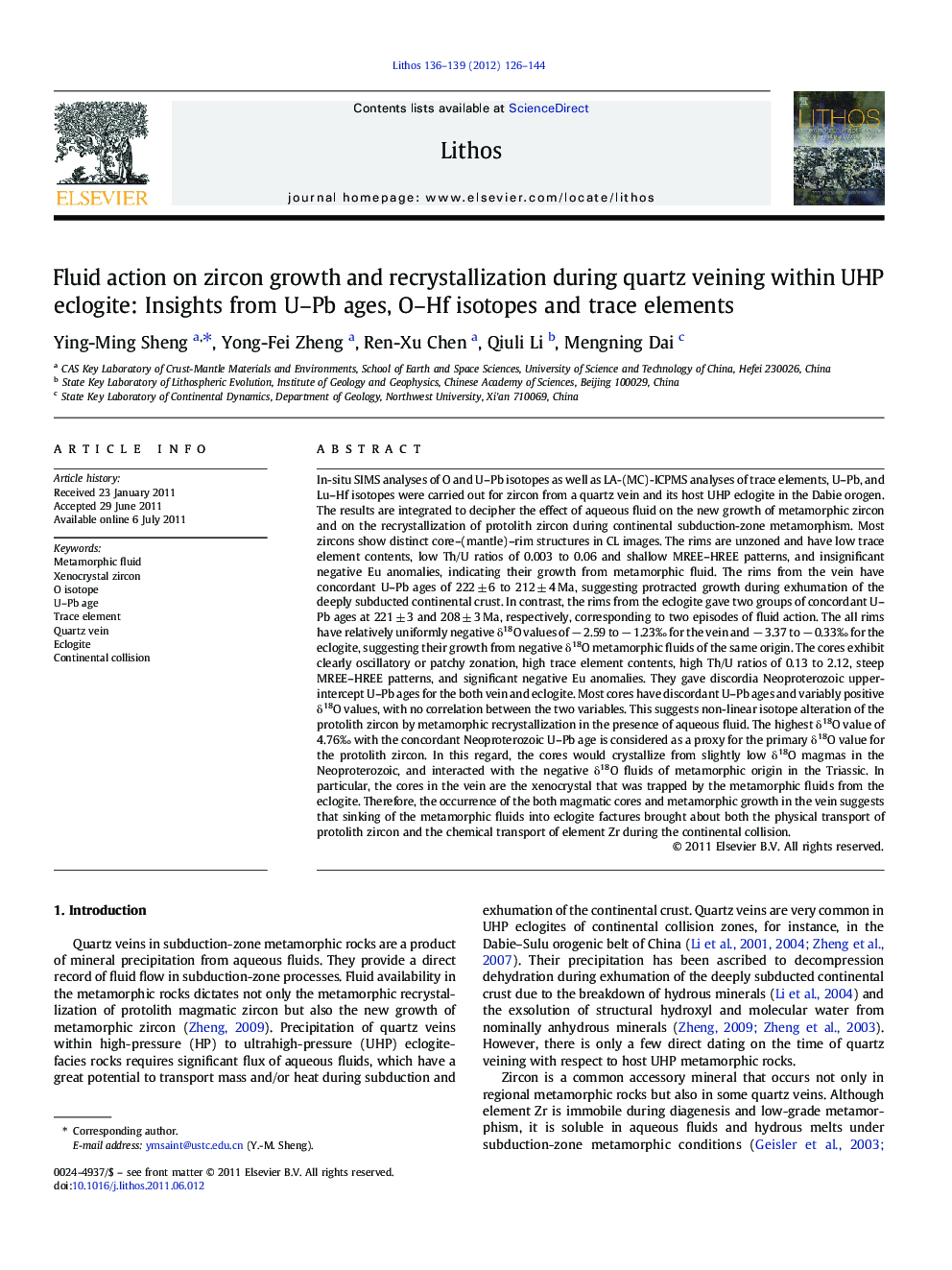| کد مقاله | کد نشریه | سال انتشار | مقاله انگلیسی | نسخه تمام متن |
|---|---|---|---|---|
| 4716645 | 1638710 | 2012 | 19 صفحه PDF | دانلود رایگان |

In-situ SIMS analyses of O and U–Pb isotopes as well as LA-(MC)-ICPMS analyses of trace elements, U–Pb, and Lu–Hf isotopes were carried out for zircon from a quartz vein and its host UHP eclogite in the Dabie orogen. The results are integrated to decipher the effect of aqueous fluid on the new growth of metamorphic zircon and on the recrystallization of protolith zircon during continental subduction-zone metamorphism. Most zircons show distinct core–(mantle)–rim structures in CL images. The rims are unzoned and have low trace element contents, low Th/U ratios of 0.003 to 0.06 and shallow MREE–HREE patterns, and insignificant negative Eu anomalies, indicating their growth from metamorphic fluid. The rims from the vein have concordant U–Pb ages of 222 ± 6 to 212 ± 4 Ma, suggesting protracted growth during exhumation of the deeply subducted continental crust. In contrast, the rims from the eclogite gave two groups of concordant U–Pb ages at 221 ± 3 and 208 ± 3 Ma, respectively, corresponding to two episodes of fluid action. The all rims have relatively uniformly negative δ18O values of − 2.59 to − 1.23‰ for the vein and − 3.37 to − 0.33‰ for the eclogite, suggesting their growth from negative δ18O metamorphic fluids of the same origin. The cores exhibit clearly oscillatory or patchy zonation, high trace element contents, high Th/U ratios of 0.13 to 2.12, steep MREE–HREE patterns, and significant negative Eu anomalies. They gave discordia Neoproterozoic upper-intercept U–Pb ages for the both vein and eclogite. Most cores have discordant U–Pb ages and variably positive δ18O values, with no correlation between the two variables. This suggests non-linear isotope alteration of the protolith zircon by metamorphic recrystallization in the presence of aqueous fluid. The highest δ18O value of 4.76‰ with the concordant Neoproterozoic U–Pb age is considered as a proxy for the primary δ18O value for the protolith zircon. In this regard, the cores would crystallize from slightly low δ18O magmas in the Neoproterozoic, and interacted with the negative δ18O fluids of metamorphic origin in the Triassic. In particular, the cores in the vein are the xenocrystal that was trapped by the metamorphic fluids from the eclogite. Therefore, the occurrence of the both magmatic cores and metamorphic growth in the vein suggests that sinking of the metamorphic fluids into eclogite factures brought about both the physical transport of protolith zircon and the chemical transport of element Zr during the continental collision.
► Combined SIMS and LA-ICPMS U–Pb dating highlights the geochemical architecture of metamorphic zircon.
► Zircon SIMS and LA-(MC)-ICPMS data on different sampling depths are integrated for genetic interpretation.
► Fluid accessibility affects the metamorphic recrystallization of magmatic zircon in continental subduction zones.
► Zircon xenocrystal in the quartz vein was trapped by metamorphic fluid from the host eclogite.
► There are the physical transport of protolith zircon and the chemical transport of element Zr by metamorphic fluid.
Journal: Lithos - Volumes 136–139, April 2012, Pages 126–144